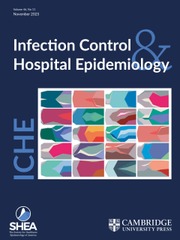Crossref Citations
This article has been cited by the following publications. This list is generated based on data provided by
Crossref.
Bercault, N.
Poisson, D.M.
Martin, P.
Garnaud, D.
Borderon, É.
and
Gueveler, C.
1993.
Résistance à la méticilline des souches de staphylococcus aureus en fonction de la durée d'hospitalisation.
Réanimation Urgences,
Vol. 2,
Issue. 4,
p.
366.
Yoshida, Tatsumi
and
Hiramatsu, Keiichi
1993.
Potent In Vitro Bactericidal Activity of Polymyxin B against Methicillin‐Resistant Staphylococcus aureus (MRSA).
Microbiology and Immunology,
Vol. 37,
Issue. 11,
p.
853.
Thevanesam, V.
Wijeyawardana, W.L.K.
and
Ekanayake, E.W.M.
1994.
Methicillin resistant Staphylococcus aureus: the scale of the problem in a Shri Lankan hospital.
Journal of Hospital Infection,
Vol. 26,
Issue. 2,
p.
123.
Hajjar, Ramzi R
Philpot, Carolyn
and
Morley, John E
1996.
CONTINUOUS BLADDER IRRIGATION WITH VANCOMYCIN FOR THE TREATMENT OF METHICELUN‐RESISTANT STAPHYLOCOCCUS AUREUS.
Journal of the American Geriatrics Society,
Vol. 44,
Issue. 7,
p.
886.
Brun-Buisson, C.
1997.
Chimio-décontamination des réservoirs de bactéries multirésistantes chez les malades et le personnel soignant.
Réanimation Urgences,
Vol. 6,
Issue. 2,
p.
245.
Maranan, Melinda C.
Moreira, Beatriz
Boyle-Vavra, Susan
and
Daum, Robert S.
1997.
ANTIMICROBIAL RESISTANCE IN STAPHYLOCOCCI.
Infectious Disease Clinics of North America,
Vol. 11,
Issue. 4,
p.
813.
Bolyard, Elizabeth A.
Tablan, Ofelia C.
Williams, Walter W.
Pearson, Michele L.
Shapiro, Craig N.
and
Deitchman, Scott D.
1998.
Guideline for Infection Control in Healthcare Personnel, 1998.
Infection Control & Hospital Epidemiology,
Vol. 19,
Issue. 6,
p.
407.
Fuchs, Peter C.
Barry, Arthur L.
and
Brown, Steven D.
2000.
Daptomycin susceptibility tests: interpretive criteria, quality control, and effect of calcium on in vitro tests.
Diagnostic Microbiology and Infectious Disease,
Vol. 38,
Issue. 1,
p.
51.
Sopena, Nieves
and
Sabrià, Miquel
2002.
Staphylococcus aureus resistente a la meticilina.
Medicina Clínica,
Vol. 118,
Issue. 17,
p.
671.
Moran, Gregory J.
Amii, Ricky N.
Abrahamian, Fredrick M.
and
Talan, David A.
2005.
Methicillin-resistantStaphylococcus aureusin Community-acquired Skin Infections.
Emerging Infectious Diseases,
Vol. 11,
Issue. 6,
p.
928.
Moran, Gregory J.
Krishnadasan, Anusha
Gorwitz, Rachel J.
Fosheim, Gregory E.
McDougal, Linda K.
Carey, Roberta B.
and
Talan, David A.
2006.
Methicillin-ResistantS. aureusInfections among Patients in the Emergency Department.
New England Journal of Medicine,
Vol. 355,
Issue. 7,
p.
666.
Rauchwerger, Jacob J.
Zoarski, Gregg H.
Waghmarae, Romanth
Rabinowitz, Ronald P.
Kent, Joel L.
Aldrich, Enslin F.
and
Closson, Carey Walter F.
2008.
Epidural Abscess Due to Spinal Cord Stimulator Trial.
Pain Practice,
Vol. 8,
Issue. 4,
p.
324.
Pantosti, A.
and
Venditti, M.
2009.
What is MRSA?.
European Respiratory Journal,
Vol. 34,
Issue. 5,
p.
1190.
Worth, L. J.
Lingaratnam, S.
Taylor, A.
Hayward, A. M.
Morrissey, S.
Cooney, J.
Bastick, P. A.
Eek, R. W.
Wei, A.
and
Thursky, K. A.
2011.
Use of risk stratification to guide ambulatory management of neutropenic fever.
Internal Medicine Journal,
Vol. 41,
Issue. 1b,
p.
82.
Kouatchet, A.
and
Eveillard, M.
2012.
Staphylococcus aureus résistant à la méticilline en réanimation.
Réanimation,
Vol. 21,
Issue. 4,
p.
493.
Kunder, Darcie A.
Cain, Christine L.
O'Shea, Kathleen
Cole, Stephen D.
and
Rankin, Shelley C.
2015.
Genotypic relatedness and antimicrobial resistance of Staphylococcus schleiferi in clinical samples from dogs in different geographic regions of the United States.
Veterinary Dermatology,
Vol. 26,
Issue. 6,
p.
406.
Goto, Michihiko
2025.
Ceftaroline for methicillin-resistant Staphylococcus aureus bacteraemia: a magic bullet, a weight on the seesaw, or neither?.
Clinical Microbiology and Infection,
Vol. 31,
Issue. 5,
p.
696.
Thomas, Abisha
Palathoti, Nagarjuna
and
Azam, Mohammed Afzal
2025.
Methicillin-resistant Staphylococcus aureus Infection and its Health Perspective: A Review.
Current Pharmaceutical Biotechnology,
Vol. 26,
Issue. 9,
p.
1331.

